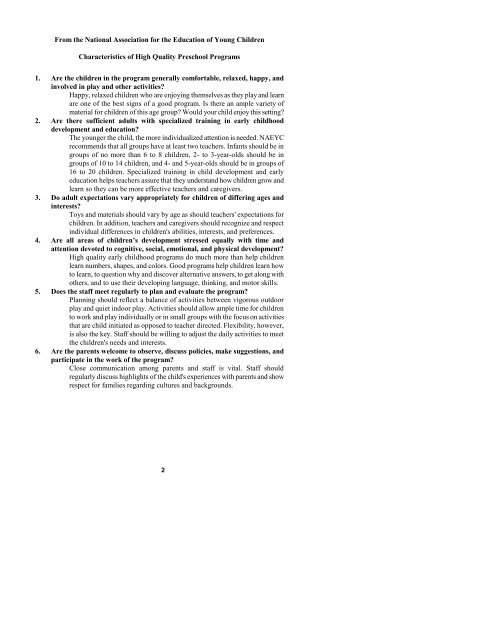Manhasset preschool guide - Gnmcccp.com
Manhasset preschool guide - Gnmcccp.com
Manhasset preschool guide - Gnmcccp.com
Create successful ePaper yourself
Turn your PDF publications into a flip-book with our unique Google optimized e-Paper software.
From the National Association for the Education of Young Children<br />
Characteristics of High Quality Preschool Programs<br />
1. Are the children in the program generally <strong>com</strong>fortable, relaxed, happy, and<br />
involved in play and other activities?<br />
Happy, relaxed children who are enjoying themselves as they play and learn<br />
are one of the best signs of a good program. Is there an ample variety of<br />
material for children of this age group? Would your child enjoy this setting?<br />
2. Are there sufficient adults with specialized training in early childhood<br />
development and education?<br />
The younger the child, the more individualized attention is needed. NAEYC<br />
re<strong>com</strong>mends that all groups have at least two teachers. Infants should be in<br />
groups of no more than 6 to 8 children, 2- to 3-year-olds should be in<br />
groups of 10 to 14 children, and 4- and 5-year-olds should be in groups of<br />
16 to 20 children. Specialized training in child development and early<br />
education helps teachers assure that they understand how children grow and<br />
learn so they can be more effective teachers and caregivers.<br />
3. Do adult expectations vary appropriately for children of differing ages and<br />
interests?<br />
Toys and materials should vary by age as should teachers' expectations for<br />
children. In addition, teachers and caregivers should recognize and respect<br />
individual differences in children's abilities, interests, and preferences.<br />
4. Are all areas of children’s development stressed equally with time and<br />
attention devoted to cognitive, social, emotional, and physical development?<br />
High quality early childhood programs do much more than help children<br />
learn numbers, shapes, and colors. Good programs help children learn how<br />
to learn, to question why and discover alternative answers, to get along with<br />
others, and to use their developing language, thinking, and motor skills.<br />
5. Does the staff meet regularly to plan and evaluate the program?<br />
Planning should reflect a balance of activities between vigorous outdoor<br />
play and quiet indoor play. Activities should allow ample time for children<br />
to work and play individually or in small groups with the focus on activities<br />
that are child initiated as opposed to teacher directed. Flexibility, however,<br />
is also the key. Staff should be willing to adjust the daily activities to meet<br />
the children's needs and interests.<br />
6. Are the parents wel<strong>com</strong>e to observe, discuss policies, make suggestions, and<br />
participate in the work of the program?<br />
Close <strong>com</strong>munication among parents and staff is vital. Staff should<br />
regularly discuss highlights of the child's experiences with parents and show<br />
respect for families regarding cultures and backgrounds.<br />
2


